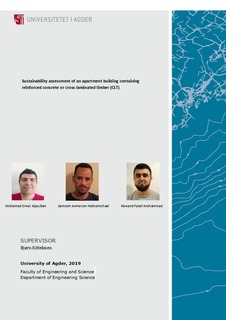| dc.description.abstract | Today, the construction industry contributes to40% of the world’s energy consumption and greenhouse gasemissions(GHGs). According to theIntergovernmental Panel on Climate Change’s(IPCC)report, the greenhouse gas emissions must be reduced by 40-50 percent to limit Global Warmingto 1.5 degreesrather than 2 degreesby 2030. The United nation’s (UN)SustainabilityGoals are the world's common work plan to stop climate change by 2030. To achieve the above goals, it is crucial for the construction sectors to look forbetter,alternative construction materials as top concern to sustainability and environmental issues.In this study, a methodology for determining a sustainable solution for a structural system of an apartment buildinghas been investigated. The study has proposed and compared three structural systems options with more focus on the environmental issue.The options are: Option 1: Timber structural system including walls and foundations made of normal concrete. Option 2: Timber structural system including walls and foundations made of low carbon concrete and option 3: Timber structural system including walls made of cross-laminated timber (CLT) and low-carbon concrete foundations. Then a comparative life cycle assessment (LCA) was carried out, as well as an analysis of construction cost. The ReCiPe LCA method is utilized to assess the impacts of the three structural systems options using SimaProsoftware based on the midpoint characterization.The findings of this study show that, the Global WarmingPotential (GWP) of option3 appears to be much lower, compared to the other two options;followed by option2 and option1. However, Land usein option3 is found to be 9% higher than the option1 and option2. GWP of option3 was 11% and 5% lower than option1 and option2 respectively. It is important to note that replacing normal concrete with low carbon concrete in option 2has reduced the GWP by 6 %. Furthermore, in option3, replacing some of the low carbon concrete walls with CLT has reduced the GWP by 5%. Based on theseLCA results, it can be concluded that structural systemscontaining low carbon concrete and CLT would havethe lowest environmental impact-of the three options studied.When it comes to construction costs, option2 was slightly more expensive than the other two options. This option was 1.3% more expensive. Surprisingly, constructioncost of low carbon concrete is only 2-3% more expensive than normal concrete. Based on an overall assessment, option3 is preferredin regard to environmental concerns; it has more positive properties than the other alternatives if one regard energy consumption,greenhouse gas emissionsand construction costs. Thus, construction sectors can achieve higher sustainability by implementingmeasures to reduce GWP, by for example replacing the normal concrete with sustainable concrete (low carbonconcrete, preferably class A) and by using timber structures (CLT and glulam) as much as practically and structurally possible. Low carbon concrete has more positive properties and its construction cost is very close to normal concrete,as mentioned it isin factonly2-3% higher. | nb_NO |

